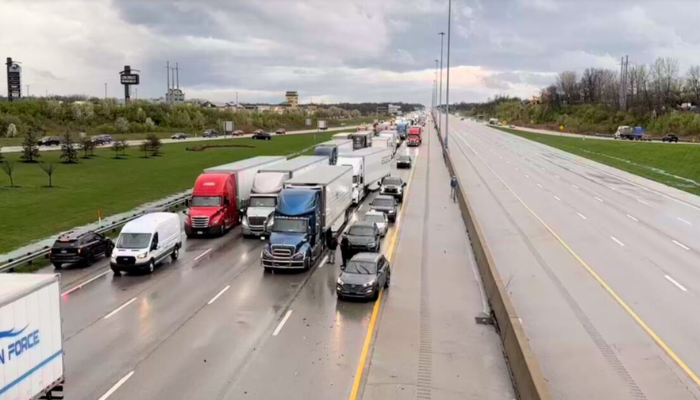The I-75 power line shutdown has become a critical issue affecting drivers, businesses, and residents living near this major highway. When a power line outage occurs along a busy interstate like I-75, the ripple effects stretch across transportation, public safety, and local infrastructure. For communities that rely on this corridor for commuting and commerce, such disruptions demand urgent attention.
Understanding the full scope of the I-75 power line shutdown doesn’t stop at traffic jams. It ties into how utility companies respond, how emergency crews prepare, and how nearby neighborhoods cope with sudden changes. In this in-depth article, we’ll unpack the causes, the consequences, the safety protocols, and what the public can expect during these shutdowns.
Understanding the I-75 Power Line Shutdown
The I-75 power line shutdown typically occurs when overhead transmission lines or utility poles are damaged, repaired, or updated. Because the interstate is a major conduit for both regional and state-wide traffic, authorities often need to shut down parts of the road for safety during repair operations. These shutdowns may happen suddenly due to accidents, storms, or planned maintenance projects.
Moreover, scheduled power line shutdowns allow utility companies to strengthen aging infrastructure. For cities along I-75 that are experiencing rapid growth, updating outdated power systems is essential. While inconvenient, the short-term disruptions help prevent larger blackouts and ensure grid reliability in the long run.
On the other hand, unplanned outages can be far more chaotic. A truck hitting a line, high winds knocking poles over, or equipment malfunctions create unpredictable closures. Traffic reroutes follow, leaving thousands of drivers searching for alternate routes. In such cases, communication from both transportation and energy authorities becomes critical to ensure public safety and minimize delays.
Causes Behind I-75 Power Line Shutdowns
One primary cause of an I-75 power line shutdown is severe weather. Storms, lightning, and high winds pose serious risks to overhead utility lines. Hurricanes and tornados can even dismantle entire sections of power grids, forcing officials to close the road until hazards are cleared. Seasonal storms across the Midwest and South make I-75 particularly vulnerable.
Another contributing factor is infrastructure aging. Much of the U.S. electrical grid was built decades ago, and I-75’s surrounding systems are no exception. As equipment deteriorates, shutdowns are required for major repairs and upgrades. Officials often schedule these projects during off-peak hours, but the disruption still lingers for commuters and businesses.
Accidents are another surprising source of I-75 power line shutdowns. Oversized trucks carrying construction equipment can strike overhead lines, leading to emergency closures. Even vehicle collisions near transmission poles on the roadside can destabilize electrical systems. These shutdowns may be brief or last several hours, depending on how badly the damage impacts the power infrastructure.
Effects on Traffic and Public Safety
When the I-75 power line shutdown happens, the most visible consequence is traffic gridlock. Thousands of vehicles can be stranded or rerouted onto city streets that are not equipped for high volumes of interstate traffic. For commuters, this means longer travel times and higher fuel consumption. For commercial drivers, delays translate into lost revenue and disrupted supply chains.
Public safety is also front and center during a shutdown. Exposed or fallen power lines pose lethal risks to anyone nearby. Authorities must block access quickly, reroute traffic, and sometimes evacuate neighborhoods if sparks or electrical fires are a threat. First responders are trained to manage both highway control and electrical hazards, ensuring that residents and drivers remain out of harm’s way.
Beyond immediate risks, shutdowns can stress local emergency systems. Ambulances and fire trucks rely on fast routes along the interstate, and closures can delay their response. Every minute counts in emergencies, so coordinated rerouting becomes essential during extended outages.
Community and Business Impact
Communities near the I-75 power line shutdown feel the disruption firsthand. Residents in adjacent neighborhoods may experience power outages, while local businesses see reduced customer visits due to blocked access. Fast-food outlets, gas stations, and logistics hubs along the route often lose significant revenue until roads fully reopen.
For businesses that rely heavily on transportation—like freight services—the impact is larger. A stalled truck on I-75 isn’t just a single delay; it can ripple across supply chains nationwide. Retailers may face empty shelves, manufacturing delays might occur, and logistics costs can spike. In essence, the power line shutdown ties directly into economic activity across multiple sectors.
Communities also face indirect issues like increased noise and congestion in residential streets as drivers search for alternate routes. Smaller towns along detour paths suddenly encounter heavy truck traffic, adding wear and tear to their local roads. These chain reactions highlight how a single shutdown can push pressure across multiple systems at once.
Solutions, Updates, and Moving Forward
In facing the I-75 power line shutdown, solutions involve both preventative measures and real-time responses. Utility providers are focusing more on hardening the grid, which means replacing old poles with stronger materials, burying lines underground, and using smart sensors for early detection of faults. These investments aim to reduce both the frequency and duration of shutdowns.
On the public side, continuous updates are key. Transportation authorities now utilize mobile apps, highway message boards, and social media alerts to inform drivers instantly about closures. This transparency enables commuters to reroute before reaching problem areas, saving time and reducing congestion during peak hours.
Looking ahead, collaboration between power companies and transportation agencies is essential. Coordinating schedules for maintenance, ensuring rapid deployment of repair crews, and expanding alternate route infrastructure are all vital to minimize public disruption. While the I-75 power line shutdown may never be fully eliminated, careful planning and investment can make it far less disruptive.
Conclusion
The I-75 power line shutdown is more than an isolated inconvenience—it’s a complex challenge that spans from infrastructure reliability to community safety. With weather, accidents, and aging systems all contributing factors, closures along this major interstate are bound to occur. However, with smarter grid technology, improved communication, and stronger cooperation between agencies, the effects can be contained and mitigated.
For drivers, businesses, and residents, staying informed and prepared is key. The shutdowns may be inconvenient, but they also serve as reminders of how vital infrastructure maintenance and modernization are for the future.
FAQs on I-75 Power Line Shutdown
- What is the I-75 power line shutdown?
It refers to the closure of sections of I-75 due to damaged or maintained power lines crossing the highway. - What causes an I-75 power line shutdown?
Common causes include storms, accidents, infrastructure repairs, and equipment failures. - How long does a typical power line shutdown last on I-75?
Shutdowns may last from a few hours to more than a day, depending on the damage. - Is it safe to drive near a power line shutdown?
Drivers are kept at a safe distance by official barriers and reroutes. It is not safe to cross closed areas. - Do shutdowns always cause power outages for nearby residents?
Not always. Some shutdowns only affect traffic, while others also cut electricity locally. - Who manages I-75 power line shutdowns?
Utility providers, state highway departments, and emergency responders coordinate efforts. - How can drivers stay updated about shutdowns?
Follow official state highway updates, mobile navigation apps, and local news reports. - Can businesses claim losses due to shutdowns?
Some may be eligible for claims through insurance, but it depends on coverage policies. - Are shutdowns planned in advance?
Repair and maintenance shutdowns are planned, but weather and accident-related ones are sudden. - What can residents do to prepare for a shutdown?
Keep emergency supplies, follow official updates, and plan alternate travel routes.










